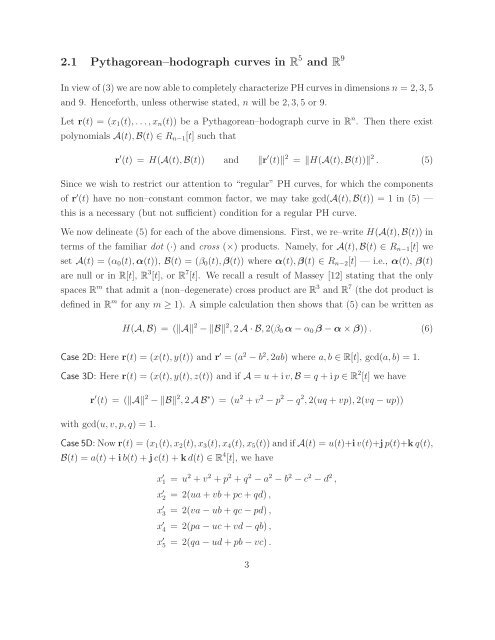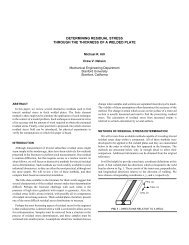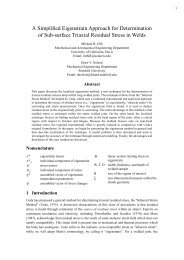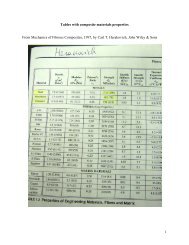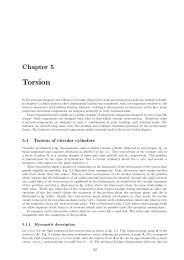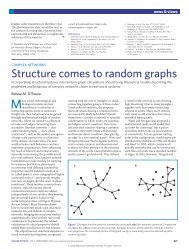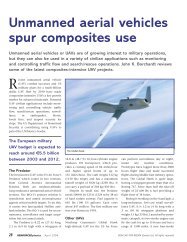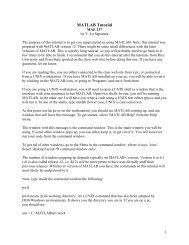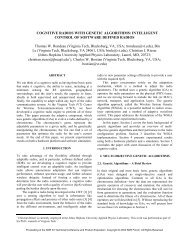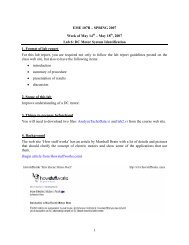Pythagorean-hodograph curves in Euclidean spaces of dimension ...
Pythagorean-hodograph curves in Euclidean spaces of dimension ...
Pythagorean-hodograph curves in Euclidean spaces of dimension ...
Create successful ePaper yourself
Turn your PDF publications into a flip-book with our unique Google optimized e-Paper software.
2.1 <strong>Pythagorean</strong>–<strong>hodograph</strong> <strong>curves</strong> <strong>in</strong> R 5 and R 9<br />
In view <strong>of</strong> (3) we are now able to completely characterize PH <strong>curves</strong> <strong>in</strong> <strong>dimension</strong>s n = 2, 3, 5<br />
and 9. Henceforth, unless otherwise stated, n will be 2, 3, 5 or 9.<br />
Let r(t) = (x1(t), . . .,xn(t)) be a <strong>Pythagorean</strong>–<strong>hodograph</strong> curve <strong>in</strong> R n . Then there exist<br />
polynomials A(t), B(t) ∈ Rn−1[t] such that<br />
r ′ (t) = H(A(t), B(t)) and r ′ (t) 2 = H(A(t), B(t)) 2 . (5)<br />
S<strong>in</strong>ce we wish to restrict our attention to “regular” PH <strong>curves</strong>, for which the components<br />
<strong>of</strong> r ′ (t) have no non–constant common factor, we may take gcd(A(t), B(t)) = 1 <strong>in</strong> (5) —<br />
this is a necessary (but not sufficient) condition for a regular PH curve.<br />
We now del<strong>in</strong>eate (5) for each <strong>of</strong> the above <strong>dimension</strong>s. First, we re–write H(A(t), B(t)) <strong>in</strong><br />
terms <strong>of</strong> the familiar dot (·) and cross (×) products. Namely, for A(t), B(t) ∈ Rn−1[t] we<br />
set A(t) = (α0(t), α(t)), B(t) = (β0(t), β(t)) where α(t), β(t) ∈ Rn−2[t] — i.e., α(t), β(t)<br />
are null or <strong>in</strong> R[t], R 3 [t], or R 7 [t]. We recall a result <strong>of</strong> Massey [12] stat<strong>in</strong>g that the only<br />
<strong>spaces</strong> R m that admit a (non–degenerate) cross product are R 3 and R 7 (the dot product is<br />
def<strong>in</strong>ed <strong>in</strong> R m for any m ≥ 1). A simple calculation then shows that (5) can be written as<br />
H(A, B) = (A 2 − B 2 , 2 A · B, 2(β0 α − α0 β − α × β)) . (6)<br />
Case 2D: Here r(t) = (x(t), y(t)) and r ′ = (a 2 − b 2 , 2ab) where a, b ∈ R[t], gcd(a, b) = 1.<br />
Case 3D: Here r(t) = (x(t), y(t), z(t)) and if A = u + i v, B = q + i p ∈ R 2 [t] we have<br />
r ′ (t) = (A 2 − B 2 , 2 A B ∗ ) = (u 2 + v 2 − p 2 − q 2 , 2(uq + vp), 2(vq − up))<br />
with gcd(u, v, p, q) = 1.<br />
Case 5D: Now r(t) = (x1(t), x2(t), x3(t), x4(t), x5(t)) and if A(t) = u(t)+iv(t)+j p(t)+k q(t),<br />
B(t) = a(t) + i b(t) + j c(t) + kd(t) ∈ R 4 [t], we have<br />
x ′ 1 = u 2 + v 2 + p 2 + q 2 − a 2 − b 2 − c 2 − d 2 ,<br />
x ′ 2<br />
x ′ 3<br />
x ′ 4<br />
= 2(ua + vb + pc + qd) ,<br />
= 2(va − ub + qc − pd) ,<br />
= 2(pa − uc + vd − qb) ,<br />
x ′ 5 = 2(qa − ud + pb − vc) .<br />
3


